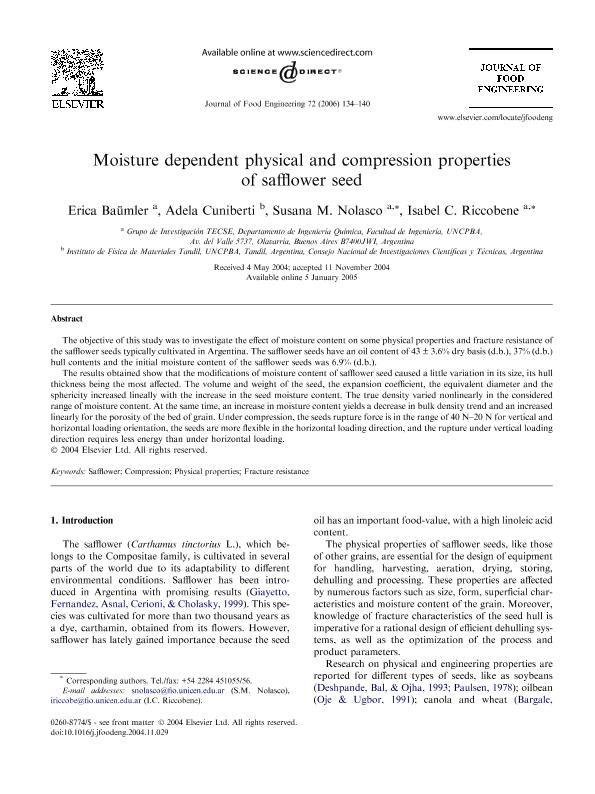Artículo
Moisture dependent physical and compression properties of safflower seed
Baumler, Erica Raquel ; Cuniberti, Adela Maria
; Cuniberti, Adela Maria ; Nolasco, Susana Maria; Riccobene, Isabel Concepción
; Nolasco, Susana Maria; Riccobene, Isabel Concepción
 ; Cuniberti, Adela Maria
; Cuniberti, Adela Maria ; Nolasco, Susana Maria; Riccobene, Isabel Concepción
; Nolasco, Susana Maria; Riccobene, Isabel Concepción
Fecha de publicación:
01/2006
Editorial:
Elsevier
Revista:
Journal of Food Engineering
ISSN:
0260-8774
Idioma:
Inglés
Tipo de recurso:
Artículo publicado
Clasificación temática:
Resumen
The objective of this study was to investigate the effect of moisture content on some physical properties and fracture resistance of the safflower seeds typically cultivated in Argentina. The safflower seeds have an oil content of 43 ± 3.6% dry basis (d.b.), 37% (d.b.) hull contents and the initial moisture content of the safflower seeds was 6.9% (d.b.). The results obtained show that the modifications of moisture content of safflower seed caused a little variation in its size, its hull thickness being the most affected. The volume and weight of the seed, the expansion coefficient, the equivalent diameter and the sphericity increased lineally with the increase in the seed moisture content. The true density varied nonlinearly in the considered range of moisture content. At the same time, an increase in moisture content yields a decrease in bulk density trend and an increased linearly for the porosity of the bed of grain. Under compression, the seeds rupture force is in the range of 40 N-20 N for vertical and horizontal loading orientation, the seeds are more flexible in the horizontal loading direction, and the rupture under vertical loading direction requires less energy than under horizontal loading.
Palabras clave:
Compression
,
Fracture Resistance
,
Physical Properties
,
Safflower
Archivos asociados
Licencia
Identificadores
Colecciones
Articulos(PLAPIQUI)
Articulos de PLANTA PILOTO DE INGENIERIA QUIMICA (I)
Articulos de PLANTA PILOTO DE INGENIERIA QUIMICA (I)
Citación
Baumler, Erica Raquel; Cuniberti, Adela Maria; Nolasco, Susana Maria; Riccobene, Isabel Concepción; Moisture dependent physical and compression properties of safflower seed; Elsevier; Journal of Food Engineering; 72; 2; 1-2006; 134-140
Compartir
Altmétricas



